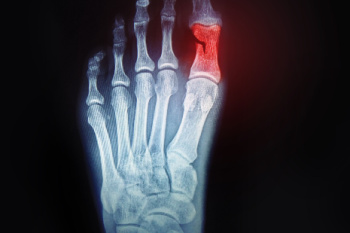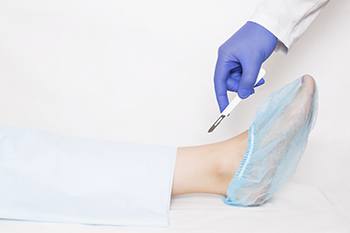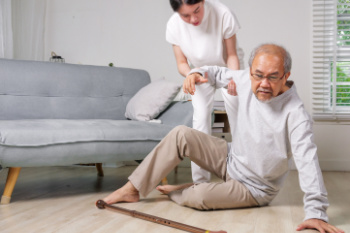

Broken toes, while often underestimated, can significantly impact daily activities and mobility. Common causes of broken toes include traumatic injuries such as stubbing or dropping heavy objects on the foot, as well as sports-related incidents and accidents. Symptoms of a broken toe typically include pain, swelling, bruising, and difficulty bearing weight on the affected foot. In severe cases, the toe may appear visibly misaligned or deformed, and there may be an audible popping or cracking sound at the time of injury. Additionally, individuals may experience numbness or tingling sensations in the affected toe. The appearance of a broken toe can vary depending on the severity of the injury, with some cases showing obvious signs of displacement or angulation, while others may have subtle swelling and discoloration. If you have fractured your toe, it is suggested that you consult a podiatrist who can perform an accurate diagnosis, and offer the treatment method that is best for you.
A broken toe can be very painful and lead to complications if not properly fixed. If you have any concerns about your feet, contact Dr. Larry Cohen from New York City. Our doctor will treat your foot and ankle needs.
What to Know About a Broken Toe
Although most people try to avoid foot trauma such as banging, stubbing, or dropping heavy objects on their feet, the unfortunate fact is that it is a common occurrence. Given the fact that toes are positioned in front of the feet, they typically sustain the brunt of such trauma. When trauma occurs to a toe, the result can be a painful break (fracture).
Symptoms of a Broken Toe
Generally, it is best to stay off of the injured toe with the affected foot elevated.
Severe toe fractures may be treated with a splint, cast, and in some cases, minor surgery. Due to its position and the pressure it endures with daily activity, future complications can occur if the big toe is not properly treated.
If you have any questions please feel free to contact our office located in Midtown, Manhattan . We offer the newest diagnostic and treatment technologies for all your foot and ankle needs.

Plantar fasciitis, a common ailment among basketball players, arises from the intense physical demands of the sport. The continuous running, abrupt stops, and sudden directional changes put immense pressure on the plantar fascia, a thick band of tissue that supports the arch of the foot. Repeated stress can lead to inflammation and micro-tears, causing excruciating heel pain. Players often find themselves grappling with the debilitating effects of this condition, hindering their on-court performance. Ignoring the initial signs can exacerbate the problem, making it imperative for basketball enthusiasts to prioritize preventative measures. Adequate warm-up routines, wearing proper footwear, and incorporating stretching exercises into the daily regimen can aid in reducing the risk of plantar fasciitis. If you have developed heel pain from playing basketball, it is strongly suggested that you consult a podiatrist who can effectively diagnose and treat plantar fasciitis.
Ankle and foot injuries are common among athletes and in many sports. They can be caused by several problems and may be potentially serious. If you are feeling pain or think you were injured in a sporting event or when exercising, consult with Dr. Larry Cohen from New York City. Our doctor will assess your condition and provide you with quality foot and ankle treatment.
Common Injuries
The most common injuries that occur in sporting activities include:
Symptoms
Symptoms vary depending upon the injury and in some cases, there may be no symptoms at all. However, in most cases, some form of symptom is experienced. Pain, aching, burning, bruising, tenderness, tightness or stiffness, sensation loss, difficulty moving, and swelling are the most common symptoms.
Treatment
Just as symptoms vary depending upon the injury, so do treatment options. A common treatment method is known as the RICE method. This method involves rest, applying ice, compression and elevating the afflicted foot or ankle. If the injury appears to be more serious, surgery might be required, such as arthroscopic or reconstructive surgery. Lastly, rehabilitation or therapy might be needed to gain full functionality in the afflicted area. Any discomfort experienced by an athlete must be evaluated by a licensed, reputable medical professional.
If you have any questions, please feel free to contact our office located in Midtown, Manhattan . We offer the newest diagnostic and treatment technologies for all your foot care needs.

Total ankle replacement, also known as total ankle arthroplasty, is a significant surgery aimed at relieving ankle pain. During the procedure, the surgeon removes parts of the shin bone, or tibia, and the top portion of the foot's highest bone, the talus, replacing the ankle with plastic or metal components. After surgery, you will likely have a cast, boot, or splint on your leg for approximately a month, and you will not be able to put weight on it immediately. You may need crutches, a walker, or a knee scooter during this time. It is important to have assistance at home during the initial recovery period. You will be discharged with bandages and stitches or staples, which your doctor will advise you on when to remove. Post-surgery, you may experience mild pain and swelling, for which your doctor may prescribe medication. Rehabilitation exercises, which are important for regaining strength and mobility, will continue for several weeks. Returning to work depends on individual recovery speed and job requirements, with certain movements or weight-bearing activities possibly restricted. If you have had your ankle replaced, it is suggested that you are under the care of a podiatrist who will provide personalized recovery steps for the most successful outcome.
In certain cases, in which the patient suffers from extreme pain or damage in a joint, joint replacement surgery may be deemed useful. If you have constant pain in a foot joint, consult with Dr. Larry Cohen from New York City. Our doctor will assess your condition and provide you with quality foot and ankle treatment.
What Is Joint Replacement Surgery?
Over time, joints wear down; this can be exacerbated by diseases and conditions. Joint replacement surgery, also known as arthroplasty, is when a damaged joint is surgically removed and replaced with a prosthesis. Prostheses, which can be made of ceramic, plastic, or metal, act as joints in lieu of an actual joint. One of the most prevalent causes for joint replacement is arthritis.
Arthritis in the Foot
Arthritis can occur in any joint in the body, including in the feet. Common types of arthritis in the foot are osteoarthritis, rheumatoid arthritis, and gout. The big toe is usually where arthritis occurs in the foot; this is known as hallux rigidus.
Joint Replacement Surgery in the Foot
The most common form of joint replacement in the foot is a first metatarsophalangeal (MTP) joint placement. MTP joint replacement surgery is designed to treat hallux rigidus. Surgery is not intensive, and recovery occurs within one to two months after the procedure has been done. Overall, joint replacement surgery is a safe and effective way to treat pain in the joint of the foot.
If you have any questions, please feel free to contact our office located in Midtown, Manhattan . We offer the newest diagnostic and treatment technologies for all your foot care needs.

The feet can be affected by falling. In older adults, this may lead to them having difficulty in completing daily activities. Ensuring a safe living space for aging loved ones is vital for their well-being and independence. Begin by decluttering walkways and removing tripping hazards such as loose rugs or electrical cords. Install handrails along stairways and in bathrooms to provide stability and support. Secure carpets and rugs with non-slip backing to prevent slips and falls. Improve lighting throughout the home, especially in hallways, staircases, and entrances. Consider installing grab bars and shower chairs in bathrooms, and keep commonly used items within easy reach to avoid the need for reaching or bending over. Additionally, consider investing in assistive devices, such as mobility aids or medical alert systems, for added safety and peace of mind. Regularly assess the home environment for potential hazards, and make necessary adjustments to promote a secure and comfortable living environment for aging loved ones. If you are seeking additional falls prevention methods that can protect the feet, it is suggested that you consult a podiatrist who can offer you valuable information.
Preventing falls among the elderly is very important. If you are older and have fallen or fear that you are prone to falling, consult with Dr. Larry Cohen from New York City. Our doctor will assess your condition and provide you with quality advice and care.
Every 11 seconds, an elderly American is being treated in an emergency room for a fall related injury. Falls are the leading cause of head and hip injuries for those 65 and older. Due to decreases in strength, balance, senses, and lack of awareness, elderly persons are very susceptible to falling. Thankfully, there are a number of things older persons can do to prevent falls.
How to Prevent Falls
Some effective methods that older persons can do to prevent falls include:
Falling can be a traumatic and embarrassing experience for elderly persons; this can make them less willing to leave the house, and less willing to talk to someone about their fears of falling. Doing such things, however, will increase the likelihood of tripping or losing one’s balance. Knowing the causes of falling and how to prevent them is the best way to mitigate the risk of serious injury.
If you have any questions, please feel free to contact our office located in Midtown, Manhattan . We offer the newest diagnostic and treatment technologies for all your foot care needs.